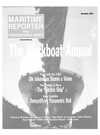
Page 22: of Maritime Reporter Magazine (November 2004)
The Workboat Annual
Read this page in Pdf, Flash or Html5 edition of November 2004 Maritime Reporter Magazine
Naval Architecture & Marine Engineering
The Physics of Parametric Roll
When momentum is small, and the pendulum is shorter, it is easier than normal to pick up speed. / V
J ot2
Therefore, the distance travelled is farther. \
When momentum is large the pendulum is longer and it is easier to move against gravity. a2 > a.
Ny a2 > ot. the new generation of large, fast, fine formed, high deck capacity containerships has refocused attention on the problem.
Forces that induce roll are always present at sea.
They are resisted by a ship's intact stability, a balanc- ing force inherent to its shape that makes the vessel behave like a pendulum in its give-and-take with the sea. Should a force cause the ship to roll, stability pro- vides the counter-force that tries to return it to the neu- tral position. The momentum of the return movement pushes the ship a little beyond neutral, a process that continues in ever-smaller swings until momentum is exhausted and the rolling stops.
In parametric roll, something happens to upset that balance. Instead of consuming momentum, the ship accumulates it, rapidly and dangerously.
Ironically, part of the problem is a consequence of good design. Below the waterline, a typical container- ship is designed for speed, with a narrow bow and stern and a full midship section. Above the waterline, it is designed to maximize on-deck stowage capacity by extending a wide main deck as far forward as possible, inducing significant bow flare, and as far aft as possi- ble with a large stern overhang.
As the vessel passes through the waves, it encounters a series of wave peaks and troughs. The speed at which this happens is called the encounter frequency. If the
Containerships are Particularly Susceptible to Parametric U<>ll ship length is close to the wavelength, it will experi- ence a series of situations in which the midship is sit- ting either deep into a peak or shallow in a trough, while, at the same moment, the bow and stern are each either shallow in a trough or deep in a peak respective- ly. In terms of the hull's contact with the sea, the ship effectively changes its beam on a regular basis, from slim (when the midship is on a peak) to wide (when the bow and stern are on peaks).
Because stability varies with beam, as the vessel drives through the series of wave fronts, its stability - the source of its resistance to roll - changes dramati- cally as the midship moves from crest (maximum) to trough (minimum). This variation is the underlying condition that drives parametric roll. vjB«P»$t
Your Best Choice - Worldwide
View & Tryout Our New 12V 6-Way Easy Seat
Adjustment on the
SeaPost Sierra EX6.LX
H.O. Bostrom Company
Made in U.S.A. Since 1946
Performance Proven
Innovations in Seating
Fax: 262-542-3784 www.hobostrom.com [email protected]
IS09001:2000
SeaPost Torsion
Shock Isolating Suspension
Circle 254 on Reader Service Card
ANCH
ANCHOR
LARGEST INVENTORY
OF NEW & USED
IN THE U.S.A. CHAINS
FAX: 713/644-1185
WATTS: 800/233-8014
PHONE: 713/644-1183
P.O. BOX 58645
HOUSTON, TX 77258
ALL TYPE
ANCHORS & CHAIN
ABS, LLOYDS
GRADE 2, 3, K-4
CHAIN & FITTINGS sales @ anchormarinehouston.com www.anchormarinehouston.com
SHACKLES — "GOLD STANDARD", forged from the finest alloy steel. Available all styles. Safety pin available in capacities up to 210 ton.
FAIRLEADS - Timken bearing equipped. Deck and flange mounted. 4" through 48" sheave diameters. Roller fairleaders also available.
BLOCKS — All bearing types available. 4" through 36" models, capacities 5 ton through 75 ton for single sheave styles.
Capacities up to 500 ton in multiple sheave models.
SHEAVES — Choice of manganese or cast steel, all types of bearings
Stock or Custom Engineered
Proved dependable throughout the world - in the roughest, toughest applications
Call for FREE Catalog: 1-800-547-8211 • www.skookumco.com
Circle 313 on Reader Service Card
Circle 210 on Reader Service Card 22 Maritime Reporter & Engineering News

 21
21

 23
23
